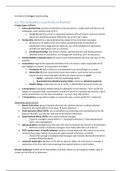Summary
Samenvatting Investeren & Beleggen (323078-B-6): alle stof, hoorcollege aantekeningen + boek
- Course
- Institution
- Book
Samenvatting van het vak Investeren & Beleggen van de volledige stof. De hoorcollege aantekeningen gecombineerd met de stof uit het boek, ingedeeld per hoofdstuk en bijbehorend hoorcollege. De samenvatting van hoofdstuk 1 en 2 is in het Engels, de rest in het Nederlands.
[Show more]




